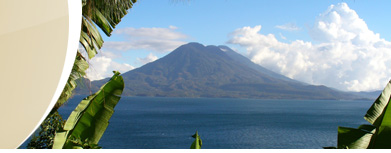GENERAL INFORMATION
Lake Atitlán was cited by author Aldous Huxley as being “the most beautiful lake in the world”. It was formed over 80,000 years ago by a violent volcanic eruption; the caldera now contains 130 km2 of sparkling water, encompassed by hills and three towering volcanoes of subsequent birth: Atitlán (3,537 m), Toliman (3,158 m), and San Pedro (3,020 m).
Being such a beautiful place, the lake has been home to many different cultures, dating back to 1000 bc or more. By 1250 the Tz’utujil Maya were established around the lake and by the 1520s they ruled over the whole of the lake area, except for a strip from Panajachel to San Antonio Palopo, which was ruled by the Kaqchikel Maya. In 1524 the Tz’utujiles surrendered to the Spanish conquistadors, their Mexican allies and the Kaqchikeles, and began paying tribute to the Spanish crown. When the Kaqchikeles refused to provide ever increasing tributes in gold, the Spanish used their old enemies the Tz’utujiles to conquer them.
Around the lake are 17 towns and villages, each with their individual characteristics, the cultures and languages still divided between Tz’utujiles and Kaqchikeles. Many of the inhabitants still wear their traditional clothing and continue the old way of life that revolved around the lake.



